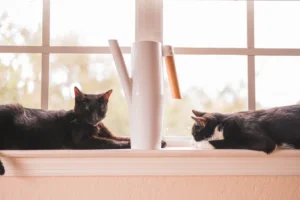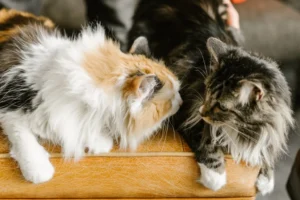Cats are known for their independent nature, but sometimes they can turn on their owners unexpectedly. This behavior can be confusing and even concerning for cat owners, leaving them to wonder why their beloved pet has suddenly lashed out. Understanding the reasons behind why cats may turn on their owners can help pet parents navigate these situations with more clarity and compassion.
Instinctual Behavior
Cats are natural predators, hardwired to hunt and protect their territory. When they turn on their owners, it might be rooted in these primal instincts. Your cat might see you as competition for resources or invade their space, triggering defensive behavior. To mitigate this, ensure your cat has enough mental and physical stimulation through toys and playtime, simulating their hunting instincts in a controlled environment.
Additionally, providing vertical space like cat trees can give them a sense of territory and control, reducing the likelihood of them turning on you due to territorial instincts. Understanding and catering to your cat’s natural instincts is crucial in fostering a harmonious relationship in the household.
Stress and Anxiety Triggers
Just like humans, cats can experience stress and anxiety, leading them to act out. Changes in their environment, such as moving to a new home or introducing a new pet, can trigger these negative emotions. Health issues like pain or discomfort can also manifest in aggressive behavior towards their owners.
To help your cat cope, create a safe and secure environment with hiding spots and soothing pheromone diffusers. Establishing a consistent routine can also provide stability and reduce their stress levels. If you notice concerning behavior, consult with your veterinarian to rule out any underlying medical issues that could be causing your cat’s aggression.
Unique Insight: Behavioral Triggers
Cats are incredibly perceptive creatures, sensitive to changes in their surroundings. Loud noises, unfamiliar scents, or even subtle changes in your behavior can trigger your cat to turn on you. Pay attention to their body language and provide a calm and predictable environment to prevent potential outbursts. By understanding and addressing these behavioral triggers, you can create a peaceful and trusting relationship with your feline friend.
Lack of Socialization
Proper socialization plays a crucial role in shaping a cat’s behavior towards its owner. Cats that have not been adequately socialized from a young age may exhibit aggression towards their owners as they lack the necessary exposure to different people, environments, and situations. This lack of socialization can lead to fear, anxiety, and defensive behavior in cats, causing them to act out aggressively. It is essential for cat owners to ensure their feline companions are properly socialized through positive interactions, exposure to various stimuli, and gradual desensitization to new experiences. By providing a well-rounded socialization experience, owners can help prevent their cats from turning on them due to fear or anxiety.
Communication Breakdown
Miscommunication between cats and their owners can often result in misunderstandings and potential aggression from the feline. Cats communicate primarily through body language, vocalizations, and behaviors that may differ from human communication cues. Failure to understand or misinterpret these signals can lead to conflicts and aggressive responses from the cat. To avoid communication breakdowns, it is crucial for cat owners to learn and understand their cat’s body language, vocalizations, and behaviors. Key signs of stress or discomfort in cats include tail flicking, dilated pupils, flattened ears, and hissing. By improving communication and responding appropriately to their cat’s cues, owners can establish a stronger bond and reduce the likelihood of aggression.
Additional Insight:
- Building trust: Cats are more likely to turn on their owners if they feel threatened or mistrustful. Building a strong bond based on trust and positive reinforcement can help prevent aggression in felines. Spend quality time with your cat, provide enriching experiences, and create a safe and comfortable environment to foster trust and reduce the chances of aggression.
Past Trauma
Past trauma can significantly impact a cat’s behavior towards their owner. Cats that have experienced abuse or neglect in the past may have developed fear or mistrust towards humans, leading to defensive or aggressive behaviors. It’s essential to approach these cats with patience and understanding, allowing them to gradually build trust through positive interactions. Creating a safe and comfortable environment can help alleviate their anxiety and prevent them from turning on their owners due to past trauma.
Seeking Attention
When cats exhibit aggressive behavior towards their owners, it could be their way of seeking attention or communicating their needs. Cats are known to be independent animals, but they also crave social interaction. If they feel neglected or overlooked, they may resort to aggressive actions to capture their owner’s attention. Spending quality time with your cat, providing interactive toys, and engaging in play sessions can help address their attention-seeking behavior and strengthen the bond between you and your feline companion.
- To address attention-seeking aggression, try engaging in regular play sessions to fulfill your cat’s need for interaction.
- Interactive toys can also help keep your cat mentally stimulated and prevent them from acting out for attention.
Remember, understanding your cat’s behavior and addressing their needs can help prevent them from turning on their owners and foster a harmonious relationship.
Behavioral Modification Techniques
If your precious feline friend is acting out and turning on you, it’s time to implement some behavioral modification techniques. Positive reinforcement training is key here. Whenever your cat displays good behavior, reward them with treats or affection. This will help them associate positive actions with positive outcomes, eventually decreasing the likelihood of aggression towards you. Consistency is key, so make sure to stick to your training routine.
Creating a Safe Environment
Creating a safe and comfortable environment for your cat is crucial in preventing them from turning on you. Make sure your cat has their own space with hiding spots and high perches to retreat to when they feel overwhelmed. Provide plenty of toys and scratching posts to keep them entertained and mentally stimulated. Additionally, ensure your cat has access to fresh water, food, and a clean litter box at all times to minimize any potential stressors.
- Avoid overcrowding: Cats need their space, so make sure they have plenty of room to roam and relax.
- Routine is key: Cats thrive on routine, so try to keep their daily schedule consistent to help them feel secure.
- Regular vet check-ups: Health issues can sometimes lead to aggression in cats, so make sure to schedule regular check-ups with your veterinarian to rule out any underlying medical conditions.
- Respect their boundaries: Cats are independent creatures, so always respect their boundaries and give them space when needed.
For more information on providing a safe environment for your feline friend, check out this resource for additional tips and insights.
Interesting Facts and Trivia
Cats communicate with their owners through a combination of body language and vocalizations. For example, if your cat is rubbing against you, they are marking you as part of their territory. When a cat’s tail is upright and slightly curved, they are feeling content and happy. On the flip side, a puffed-up tail signals fear or aggression. Understanding these cues can help you interpret your cat’s emotions better.
Here are some fun facts about cat behavior: – Cats have a unique way of showing affection by blinking slowly. Return the gesture to strengthen your bond. – Cats have scent glands on their cheeks, which they use to mark their favorite people or objects. – Cats often bring “gifts” like dead prey to their owners. This behavior stems from their instincts as hunters.
Remember, cats are complex creatures with their own ways of communicating. Pay attention to their body language and vocal cues to foster a deeper understanding of your feline friend.
Insights into Cat Behavior
It’s essential to recognize that cats may display aggression towards their owners for various reasons. One commonly overlooked factor is stress. Cats are sensitive creatures, and changes in their environment can trigger feelings of anxiety or fear, leading to defensive behavior. If your cat suddenly turns on you, consider any recent changes in their surroundings that may be causing them distress.
Additionally, medical issues can also manifest as aggression in cats. Pain or discomfort can make even the most docile cat lash out. If your cat’s behavior changes suddenly, it’s vital to consult with a veterinarian to rule out any underlying health issues.
By addressing potential stressors and ensuring your cat’s physical well-being, you can help mitigate aggressive behavior and strengthen your bond with your furry companion.
Alex, a passionate animal lover, has experience in training and understanding animal behavior. As a proud pet parent to two dogs and three cats, he founded AnimalReport.net to share insights from animal experts and expand his knowledge of the animal kingdom.









